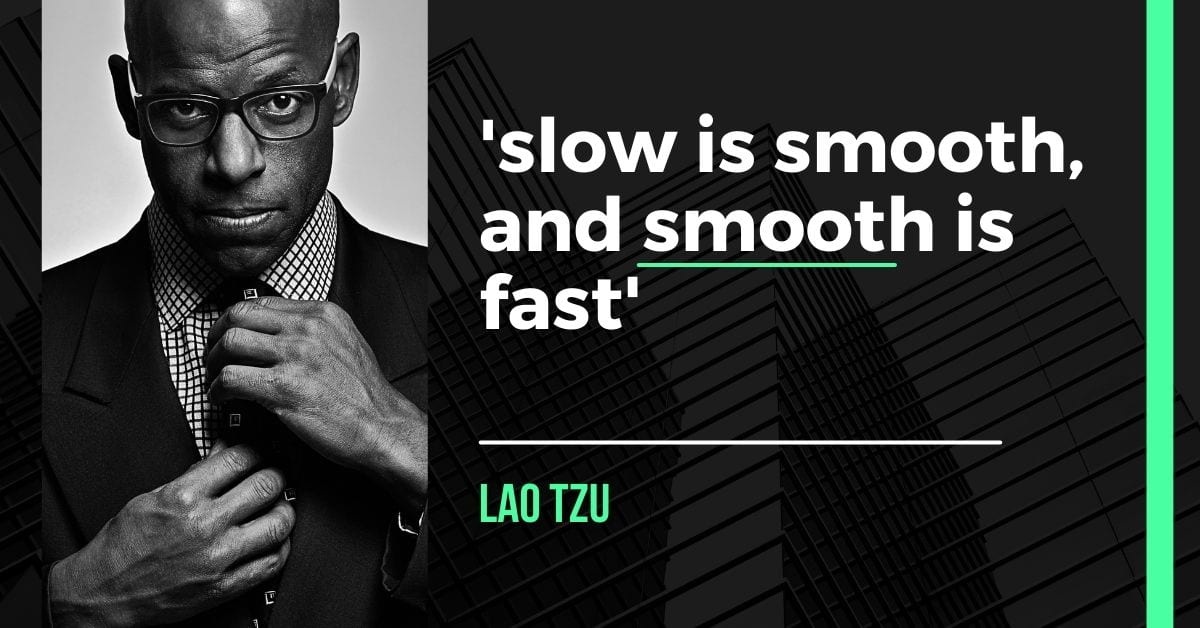Welcome to the mysterious world of quotes and their origins! Have you ever encountered a saying that resonates with you so deeply that it feels like it holds some secret wisdom? One such phrase that has captured the attention of many is “Slow is smooth, and smooth is fast.” It’s concise yet profound, provoking curiosity about its origin and meaning.
In this blog post, we’ll embark on a quest to unravel the mystery behind this powerful expression. Join us as we delve into its historical context, explore common usage and misattributions, examine famous examples, discuss its impact on military and sports training, and even discover how it can be applied in our everyday lives. Get ready for an enlightening journey through time – one slow step at a time!
Contents
Origin of the Phrase
The origin of the phrase “Slow is smooth, and smooth is fast” is shrouded in mystery, leaving us to wonder who first uttered these wise words. While it’s challenging to pinpoint a specific individual, this powerful mantra has been embraced by various disciplines over the years.
Some believe that its origins lie within military training. The concept of deliberate and controlled movements can be traced back to ancient martial arts practices. It emphasizes the importance of mastering each step before progressing swiftly through a sequence – a lesson taught in combat situations where split-second decisions can mean life or death.
Others argue that the phrase originated from sports training, particularly in activities requiring precision and finesse. Athletes understand that rushing through motions without proper technique often leads to mistakes and setbacks. They ultimately achieve better results by focusing on executing movements with grace and fluidity.
Regardless of its inception, ‘Slow is smooth, and smooth is fast’ embodies a universal truth applicable beyond any particular context. It reminds us that taking time and being deliberate allows for greater control and efficiency.
So even if we may never know precisely who coined this saying initially (and does it matter?), what matters most is embracing its wisdom as we navigate our journeys – one slow but purposeful step at a time!
Historical Context and Meaning
To truly understand the meaning behind the phrase “slow is smooth, and smooth is fast,” it’s essential to delve into its historical context. While no definitive origin is attributed to this saying, it has been used in military training for decades.
The concept behind this phrase is rooted in the idea that one can achieve efficiency and effectiveness by taking deliberate and controlled actions. In military operations, where split-second decisions can mean life or death, being slow but precise allows smoother execution.
This principle extends beyond the battlefield, finding relevance in various areas of life. Focusing on quality rather than speed can be applied across different fields – from sports training to everyday activities such as cooking or driving.
Individuals can avoid mistakes and achieve better results by emphasizing a systematic approach over rushing through tasks haphazardly. It encourages people to prioritize skill development and attention to detail rather than solely aiming for quick outcomes.
In essence, “slow is smooth, and smooth is fast” serves as a reminder that patience and carefulness lead to greater overall efficiency. By embracing this mindset in our daily lives, we can enhance our productivity while maintaining precision – an invaluable lesson that resonates throughout history.
Common Usage and Misattributions
“slow is smooth, and smooth is fast” has become a famous mantra in various fields. It often emphasizes the importance of taking things steadily and methodically to achieve optimal results. While its origins can be traced back to military training, the saying has transcended its original context and found widespread use.
However, like many famous quotes, several misattributions are associated with this phrase. It is often mistakenly credited to ancient Chinese philosophers or martial arts masters. In reality, the exact origin of this saying remains to be determined.
Despite these misattributions, “slow is smooth, and smooth is fast” resonates with people from all walks of life. Whether you’re an athlete striving for peak performance or a student preparing for exams, embracing a calm and deliberate approach can lead to better outcomes.
Athletes often adopt this motto in sports training to improve their skills. By focusing on perfecting each movement rather than rushing through them haphazardly, athletes can enhance their overall performance on the field or court.
Similarly, in military training scenarios where split-second decisions can mean life or death, soldiers are taught that staying calm under pressure leads to faster and more effective responses. The idea is that remaining composed even in chaotic circumstances allows individuals to think clearly and make well-informed choices.
Beyond athletic endeavors or combat situations, though, this principle also holds value in everyday life; from completing tasks at work efficiently to maintaining harmonious relationships with others – applying a measured approach helps us navigate challenges smoothly while achieving desired outcomes effectively.
Famous Examples of ‘Slow is Smooth, Smooth is Fast’
Notable Examples of ‘Slow is Smooth, Smooth is Fast’
1. Bruce Lee:
Renowned martial artist and actor Bruce Lee exemplified the concept of ‘slow is smooth, smooth is fast’ in his approach to combat. He emphasized mastering the fundamentals and refining techniques through deliberate practice. He achieved lightning-fast strikes with seemingly minimal effort by focusing on precision and fluidity rather than speed alone.
2. Michael Jordan:
The basketball legend often referred to this phrase when describing his approach to the game. Jordan believed that by maintaining a calm and controlled demeanor on the court, he could make split-second decisions more effectively, leading to smoother execution and, ultimately, better performance.
This maxim has been embraced by elite military units such as the Navy SEALs, who understand that rushing into action without careful planning can lead to disastrous outcomes. By meticulously rehearsing every aspect of their missions, they ensure seamless execution under high-pressure situations.
4. Formula One drivers:
In motorsports, where split-second decisions determine victory or defeat, drivers like Ayrton Senna have embodied this principle. They prioritize smoothness in their driving style over reckless speed, allowing them to maintain control while pushing boundaries at incredible speeds.
5. Olympic sprinters:
Athletes like Usain Bolt demonstrate that even in explosive sports like sprinting, adopting a measured approach can yield superior results. By focusing on fluid movements during training instead of solely chasing raw speed, they achieve efficiency and maximum velocity when it matters most.
These examples illustrate how individuals across various fields have recognized the power of ‘slow is smooth, smooth is fast.’ It shows that taking time for deliberate practice and emphasizing technique over sheer haste can lead to remarkable achievements in any endeavor one pursues
Impact on Military and Sports Training
The phrase “slow is smooth, and smooth is fast” has significantly impacted military and sports training. This concept emphasizes the importance of precision and efficiency in executing tasks in military operations. It teaches soldiers to focus on performing each step correctly without rushing or making mistakes that could have dire consequences.
In terms of sports training, this philosophy promotes the idea that mastering basic skills with fluidity leads to enhanced performance. Athletes are encouraged to break down complex movements into smaller components, practicing them slowly until they become second nature. This approach allows for muscle memory development, leading to faster execution when competition requires speed.
By incorporating the principle of “slow is smooth, and smooth is fast,” military personnel and athletes can improve their effectiveness in high-pressure situations. Whether executing a tactical maneuver or hitting a winning shot, attention to detail and deliberate practice contribute to better outcomes.
Both military units and sports teams benefit from individuals who understand that taking time to develop proficiency pays off in the long run. When every action counts towards success or failure, being methodical rather than hasty can be the critical difference between victory and defeat.
Personal Application in Daily Life

How can “Slow is smooth, and smooth is fast” be applied to our daily lives? While its origins may lie in military and sports training, the wisdom behind this saying holds for all aspects of life.
In our fast-paced world, we often find ourselves rushing from one task to another without taking a moment to breathe. Being busy means being productive. However, embracing a slower approach can lead to greater efficiency and effectiveness.
By focusing on performing each task with precision and mindfulness, we can avoid careless mistakes from rushing. Taking the time to plan and strategize allows us to navigate challenges smoothly rather than encountering obstacles.
Moreover, adopting a slow and deliberate mindset helps us cultivate patience. Instead of succumbing to frustration or impatience when things don’t go as planned, we learn how to adapt gracefully. This reduces stress and opens up opportunities for innovation and creativity.
When it comes to personal relationships, applying the “slow is smooth” principle encourages us to listen attentively and communicate thoughtfully. We foster understanding and connection with others by slowing down our responses instead of reacting impulsively.
Furthermore, this philosophy reminds us not to rush through life’s experiences but rather savor each moment fully. Whether it’s enjoying a meal with loved ones or walking in nature, slowing down genuinely allows us to appreciate the beauty around us.
Incorporating the concept of “Slow is smooth” into our daily lives enables us to be more present in every activity we undertake. It teaches us patience while enhancing productivity by encouraging careful planning and execution. By embracing this mindset personally, we can experience deeper connections with others while finding joy in even the simplest moments life has to offer
Conclusion
- The phrase “Slow is smooth, and smooth is fast” has a rich history that spans various contexts and disciplines. While its exact origin may be difficult to trace, it has become widely recognized in military and sports training and everyday life.
- This powerful mantra emphasizes the importance of taking deliberate actions, being mindful of every movement, and maintaining a steady pace. We can achieve greater efficiency and success by executing tasks smoothly rather than rushing through them haphazardly.
- Throughout history, numerous individuals have embodied this philosophy without even realizing it. From ancient warriors to modern athletes, the concept of slow yet graceful movements leading to faster overall performance has been ingrained in their training methods.
- While many misattributions surround those who first uttered these words, what truly matters is their impact on countless individuals seeking improvement in their respective fields. Whether you’re a soldier preparing for battle or an athlete striving for greatness, embracing this mindset can make all the difference.
- But it’s not just limited to military tactics or sports; it also holds relevance in our daily lives. Adopting a slower approach while handling tasks or making decisions allows us time for thoughtful consideration and avoids unnecessary errors or setbacks caused by haste.
- The phrase “Slow is smooth, and smooth is fast” reminds us that sometimes slowing down can lead us to our goals more quickly and efficiently. So let us embrace this wisdom from unknown origins and apply its principles wherever applicable – because when we strive for smoothness rather than simply speediness alone – true success awaits us!
Good luck, Habibi!
Come to the website and explore some mind-blowing content.
- Why Every Fashionista Needs a pork pie hat in Their Wardrobe

- Ultimate Guide to Shopping for parachute pants: Where to Buy, What to Look For

- Exploring the Delicate Flavors of tagliolini Pasta: A Culinary Journey

- Uncovering the Truth Behind blog del narco: A Deep Dive into Mexico’s Drug War

- Exploring the History and Tradition of cempasuchil in Day of the Dead Celebrations

- The Ultimate Guide to boquerones: How to Prepare and Enjoy these Spanish Delicacies






